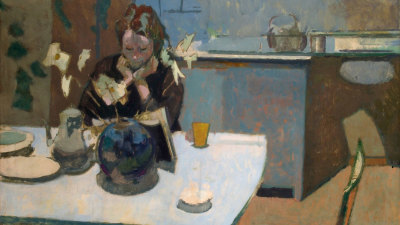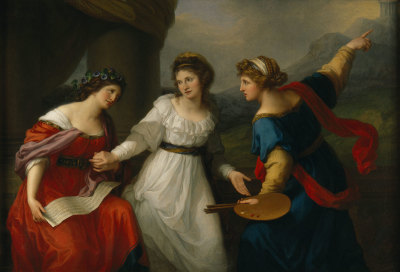
Angelica Kauffman RA, Design, 1778-80.
Oil on canvas. 1260 mm x 1485 mm x 25 mm. © Photo: Royal Academy of Arts, London. Photographer: John Hammond.
This image is not available to download. To licence this image for commercial purposes, contact our Picture Library at picturelibrary@royalacademy.org.uk
Design, 1778-80
Angelica Kauffman RA (1741 - 1807)
RA Collection: Art
Supported by Ina De & James Spicer
A female artist wearing working clothes intently studies a classical cast. She is an allegorical figure, meaning she represents an idea; in this case, ‘design’, or ‘drawing’, as one of the four elements of art. She copies a cast of the Belvedere Torso, one of the best known classical sculptures, which is found in the Museo Pio-Clementino of the Vatican Museum, Rome (cat. 1192). A cast of this figure is in the Royal Academy collection (03/1442). During Kauffman's period, artists started their training by drawing casts and Kauffman would have trained in this way. Unlike her male colleagues however, Kauffman was unable to progress to the next stage of drawing from life models, as women were forbidden. Linberg writes that, although male artists frequently represented female bodies, it was rare for a woman to draw a male body – even an antique torso (Linberg, p.30).
The figure sits at the base of two Roman columns. Clouds and mountains are seen in the distance, but rather than showing a specific landscape, they seem to symbolically indicate nature to contrast with the cast and columns, which represent culture (Linberg, p.26).
Angelica Kauffman’s four paintings collectively represent the ‘Elements of Art’: Invention, Composition, Design and Colour. Some contemporary references also used the title Colouring. They represent Joshua Reynold’s theories in his Discourses on Art, given in lectures at the Royal Academy and later published in 1788.
In Design and Colour the figures are physically engaged in the act of creation whereas in Composition and Invention the figures are engaged in reflection. In Invention the figure looks to the sky for inspiration and in Composition she is deep in thought with her head in her hands. When displayed in the ceiling, the paintings are paired, with one practical and one theoretical at each side of the room.
Kauffman represented strong female bodies inspired by examples from the Italian Renaissance. Linberg writes that Kauffman’s women “radiate both spiritual and physical vitality, in a way that, at least on the face of it, has a resemblance to, for example, Michelangelo’s athletic sibyl in the ceiling of the Sistine Chapel, which Angelica Kauffman must have seen and studied, or to Artemisia Gentileschi’s history painting” (Linberg, p.26).
Artists and viewers of art in the 18th century would have been well versed in reading iconography and Kauffman’s works contain many symbols sourced from classical iconographic traditions. She would have seen dictionaries of iconography such as Cesare Ripa’s Iconologia. Kauffman’s Invention follows the aesthetic tradition described by Ripa as a young woman, dressed in white, as Invention is pure. She has two wings from her head and a raised arm showing the elevation of intellect. Painting is described as beautiful with wavy, thick hair holding a palette in one hand and a brush in the other. This description fits Kauffman’s Painting, but Kauffman seems to be rare in using the rainbow and chameleon as symbols of colour; instead they were traditionally used in iconography representing Air. Design can be seen to represent the Italian term Disegno, a term closer to drawing today. Disegno is described as a young man holding a mirror and a compass. A compass is found in Kauffman’s Composition – the other practical element. It is interesting to note that, although tradition may have made some of the figures male, Kauffman created all female figures.
Linberg argues that these figures represent self-portraits as well as allegories, which is something Kauffman is known to have done in other works. She writes that Kauffman “makes use of a combination, impossible for the male artist, of self-portrait and Muse” (Linberg, p.27). Although Kauffman did portray strong, working women, as she herself wanted to be viewed, it is unlikely that she was creating explicit self-portraits. The figure in Colour is partially unclothed and it is unlikely Kauffman would have represented herself in this way, as she was fiercely protective of her reputation. Furthermore, in his 1781 guide to Somerset House, Baretti describes the four figures as being at different stages of life: Colour is a “blooming young Virgin”; Invention is “in the flower of her age”; and Composition is “somewhat more advanced in life than Invention” (Baretti, p.26).
The paintings were commissioned for the Royal Academy’s Council Room in the institution’s first purpose-built home in Somerset House in a design by Sir William Chambers RA. They were part of a scheme with paintings by Benjamin West in the centre including The Graces Unveiling Nature (03/1127) and the four elements: Earth (03/1125), Air (03/1123), Water (03/1124) and Fire (03/1126). While Kauffman represents active female figures, West’s are passive. Kauffman was paid £100 for her four paintings and West £125 for his five. 12 portraits by Biagio Rebecca surrounded the scheme, but these are now lost. Design and Composition can be seen on the ceiling of the Council Room in Henry Singleton’s painting The Royal Academicians in General Assembly from 1795 (03/1310).
When the Royal Academy left Somerset House in 1837 to a shared building with the National Gallery in Trafalgar Square, the ceiling paintings were transferred. While documents in the Royal Academy’s archive indicate the paintings were displayed in the Council Room in Trafalgar Square, as they had been at Somerset House (Council minutes XX, 1899, p.431 and GA minutes, 1899, pp.57-58), Hutchison writes that West’s paintings were in the Council Room but Kauffman’s were in the library (Hutchison, 1986, p.88). A drawing in the National Archives from 1832 of the design for the Council Room at Trafalgar Square shows space allocated for both the West and Kauffman paintings (WORKS 33/939). However, as the drawing dates from before the Royal Academy moved, it is unclear whether this scheme was used.
The ceiling paintings were later transferred to the ceiling of the entrance hall for the Royal Academy at Burlington House in a design by T.G. Jackson. The proposal to hang them there was included in the General Assembly minutes on 20 July 1899, 32 years after the Royal Academy had moved to Burlington House. It was explained “since the removal of the academy to Burlington House [the paintings] had been lying unused in the basement, it became a question whether something might not be done to further improve the somewhat mean aspect of the Hall” (GA minutes, 1899, pp.57-58).
Related Works
The grisaille studies for the paintings are in the collection of the Victoria & Albert Museum: Design (E.866-1948); Composition (E.864-1948); Colouring (E.863-1948); and Invention (E.865-1948).
Further Reading
Joseph Baretti, A Guide Through the Royal Academy, London: Royal Academy of Arts, 1781, p.26.
Sidney Hutchison, The History of the Royal Academy 1768-1986, 1986 (2nd ed.), London: Robert Royce.
Wendy Rassyng Roworth, Angelica Kauffman: A Continental Artist in Georgian England, London: Reaktion Books, 1992, p.68.
Object details
1260 mm x 1485 mm x 25 mm
Associated works of art
4 results
Start exploring the RA Collection
- Explore art works, paint-smeared palettes, scribbled letters and more...
- Artists and architects have run the RA for 250 years.
Our Collection is a record of them.







